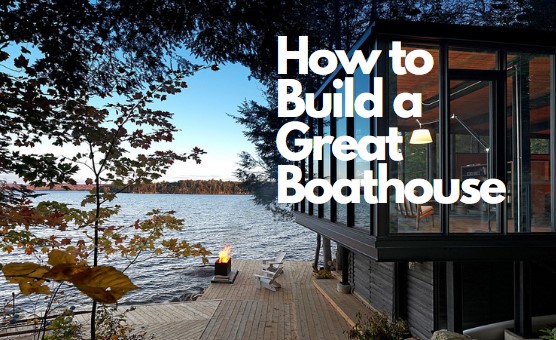
A boathouse that appears to be floating on the water is one of the most romantic and beautiful forms of architecture, but there are many technical and aesthetic complexities involved in building one correctly. That’s why you’ll want to deal only with builders, engineers, and architects experienced in building on or near the water. By Carrie Coolidge, Barrons.com.

Consider that boathouse permits, regulations, and restrictions vary from state to state. In New Hampshire, for example, you’ll need a wetlands permit. Looser rules apply to grandfathered structures built on tidal waters before June 22, 1967, and on freshwater before July 2, 1969. Depending on the location, there may be restrictions with regards to length and width. Sometimes a permanent dock isn’t allowed.
The most complex issue to conquer is the house’s underwater support. Look at old surveys and maps, if they exist, and build at least 18 inches above the record high-water mark. Fluctuating water depth, soil type, conditions under the water’s surface, and the land’s slope to the shoreline all affect the type of support and determine the foundation’s maximum bearing capacity, says Thomas Moore, an architect at Mackey Mitchell Architects in St. Louis.
Building a solid foundation is key. A geotechnical engineer should oversee the digging of test pits to determine the bearing capacity of the soil and how much mud needs to be excavated to get to a solid surface, such as bedrock, that can support the building load. “Make something that will last,” says Moore. “If you want a permanent structure that will be there for your grandchildren, do not skimp on the foundation.”
To build a boathouse on a lake near St. Louis that could double as an entertaining space and guesthouse, Moore opted to install a series of metal tripods that extended from the bank. These tripods were covered with a strong waterproof tarp a couple of feet above the waterline. The marked-off foundation area within was then drained of water over several months, creating a watertight structure called a cofferdam.

Concrete columns 18 in. in diameter were installed, crushed stone was added, and a 10-in.-thick epoxy-reinforced concrete platform was constructed atop, hovering above the water. The platform was built to withstand all types of extreme weather conditions, including blizzards, sun exposure, and earthquakes. The main structure was built on top with a series of steel frames placed six to eight feet apart.
Determining the optimal height of the boat-storage space is also key, says Moore. He made sure, for example, that the slips in the Adirondack-style boathouse had enough space to secure hydraulic winches, so a boat could be easily lifted out of the water during the off-season, or when cleaning the hull.
Moore also opted for cedar siding. It’s durable and elegant but needs occasional resealing. He topped the slate-covered roof with a cupola for a bit of extra flair. All bolts were made of stainless steel, and the interior of the boat room features corrosion-resistant materials and Douglas fir finishes. The window frames and dock doors are made of aluminum cladding.
There is, of course, a ramp into the water alongside the boathouse; its impact on the shoreline had to be determined and approved by zoning officials. A small lift station was added to help get the boathouse’s sewage to an existing sewer near the lake; all water lines were heat taped and insulated. Moore recommends installing, as he did, a geothermal compressor that draws heat from warm water deep underground. The compressor will provide heat in the winter and can be reversed to cool the living quarters during the warmer months. “It will cost more money upfront, but the payback period is fairly short,” says Moore.
The cost to build a boathouse is comparable to a similar land-based structure, says Moore, except for the first-stage support and platform built in the water. That costs about 30% to 50% more than constructing a land-based foundation. Sometimes a cantilevered structure made of galvanized steel is installed rather than an underwater platform, but that will greatly add to your costs.
Moore’s boathouse has an outside deck with a barbecue. Within the boat-storage area, there’s a kitchenette, changing area, bathroom with a shower, and mechanical room. Upstairs, there’s a 1,200-square-ft. open layout that features oak floors, a chef’s kitchen, changing area, full bathroom, and ceiling with exposed beams.
The result is a gracious and inviting retreat to entertain and house a guest—and, of course, launch a boat.

View original post here.
Re-posted by Scott Freerksen “The Lake Guy”
